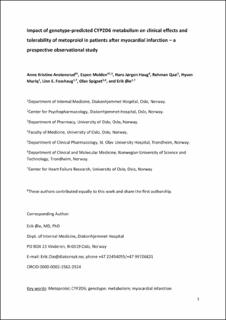| dc.contributor.author | Anstensrud, Anne Kristine | |
| dc.contributor.author | Molden, Espen | |
| dc.contributor.author | Haug, Hans Jørgen | |
| dc.contributor.author | Qazi, Rehman | |
| dc.contributor.author | Muriq, Hysen | |
| dc.contributor.author | Fosshaug, Linn Elisabeth Lillerud | |
| dc.contributor.author | Spigset, Olav | |
| dc.contributor.author | Øie, Erik | |
| dc.date.accessioned | 2021-02-23T12:17:47Z | |
| dc.date.available | 2021-02-23T12:17:47Z | |
| dc.date.created | 2021-01-18T11:24:13Z | |
| dc.date.issued | 2020 | |
| dc.identifier.citation | European Journal of Clinical Pharmacology. 2020, 76 673-683. | en_US |
| dc.identifier.issn | 0031-6970 | |
| dc.identifier.uri | https://hdl.handle.net/11250/2729790 | |
| dc.description.abstract | Purpose The β-1 adrenergic receptor blocker metoprolol is primarily metabolized by the polymorphic enzyme cytochrome P 450 2D6 (CYP2D6), an enzyme with substantial genetic heterogeneity. Our purpose was to investigate the impact of CYP2D6 metabolism on clinical effects and tolerability of metoprolol in patients after myocardial infarction (MI). Methods We included 136 patients with MI discharged on treatment with metoprolol with a recommendation to the general practitioner (GP) to increase the metoprolol dose up to 200 mg/day within 2 months if possible. At follow-up, metoprolol dosage after up-titration, metoprolol steady-state trough plasma concentrations, hemodynamic parameters, potential metoprolol-induced adverse drug reactions and number of visits to the GP were measured. CYP2D6 genotyping including the reduced-function variant alleles CYP2D6*9, CYP2D6*10 and CYP2D6*41 was performed after end of follow-up. Results According to the genotype-defined CYP2D6 phenotypes, 30% of the patients were metoprolol extensive metabolizers (EMs), 55% intermediate metabolizers (IMs) and 13% poor metabolizers (PMs; carriers of non-coding and reduced-function variant included). Dose-adjusted metoprolol trough concentrations were significantly higher in IM (2-fold) and PM (6.2-fold) groups vs. the EM group (p < 0.001). Only 35% of patients in the PM group achieved the primary end point, i.e. reaching at least 85% of the expected maximum heart rate (HR) during exercise, compared with 78% in the EM group (p < 0.01), and maximum observed HR at exercise was significantly lower in the PM group vs. the EM group (129 ± 5 vs. 142 ± 2 bpm, p < 0.007). In contrast, metoprolol maintenance dose, blood pressure, exercise capacity, number of visits at the GP and frequency and severity of self-reported potential metoprolol-related adverse drug reactions were not significantly different between the groups. Conclusion Using a comprehensive CYP2D6 genotyping panel, the present study demonstrates a > 6-fold increase of dose-adjusted plasma metoprolol trough concentration in CYP2D6 PMs vs. EMs with a parallel lower increase in achieved maximum HR during exercise but without association between genotype and frequency or severity of self-reported adverse drug effects. This may indicate that CYP2D6 PMs potentially could benefit of the increased plasma concentration per dose in a naturalistic setting. | en_US |
| dc.language.iso | eng | en_US |
| dc.publisher | Springer | en_US |
| dc.title | Impact of genotype-predicted CYP2D6 metabolism on clinical effects and tolerability of metoprolol in patients after myocardial infarction – a prospective observational study | en_US |
| dc.type | Peer reviewed | en_US |
| dc.type | Journal article | en_US |
| dc.description.version | acceptedVersion | en_US |
| dc.source.pagenumber | 673-683 | en_US |
| dc.source.volume | 76 | en_US |
| dc.source.journal | European Journal of Clinical Pharmacology | en_US |
| dc.identifier.doi | 10.1007/s00228-020-02832-0 | |
| dc.identifier.cristin | 1873056 | |
| dc.description.localcode | "This is a post-peer-review, pre-copyedit version of an article. Locked until 15.1.2021 due to copyright restrictions. The final authenticated version is available online at: http://dx.doi.org/10.1007/s00228-020-02832-0 | en_US |
| cristin.ispublished | true | |
| cristin.fulltext | postprint | |
| cristin.qualitycode | 2 | |
